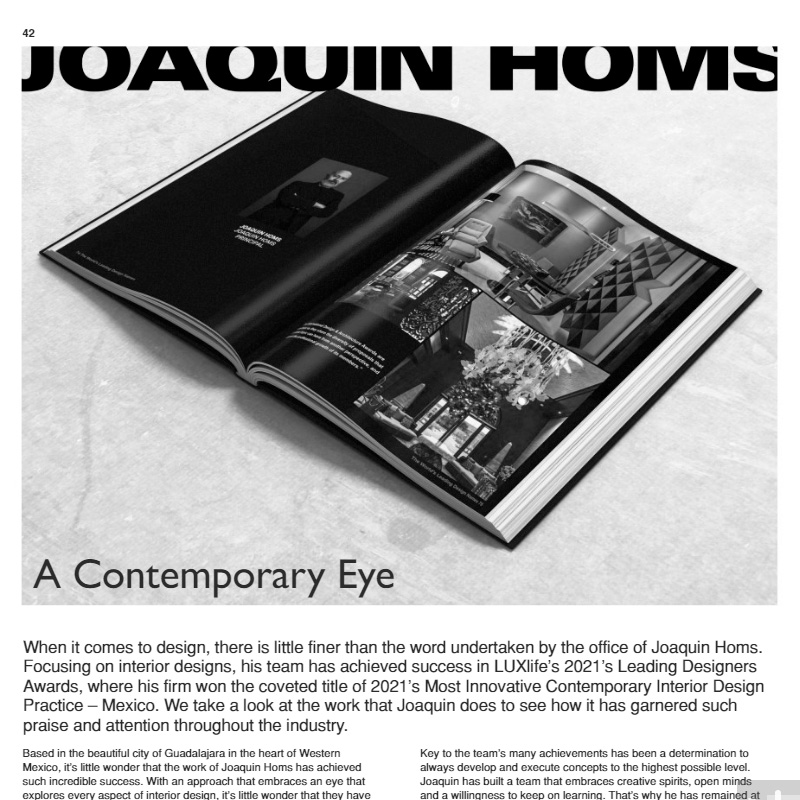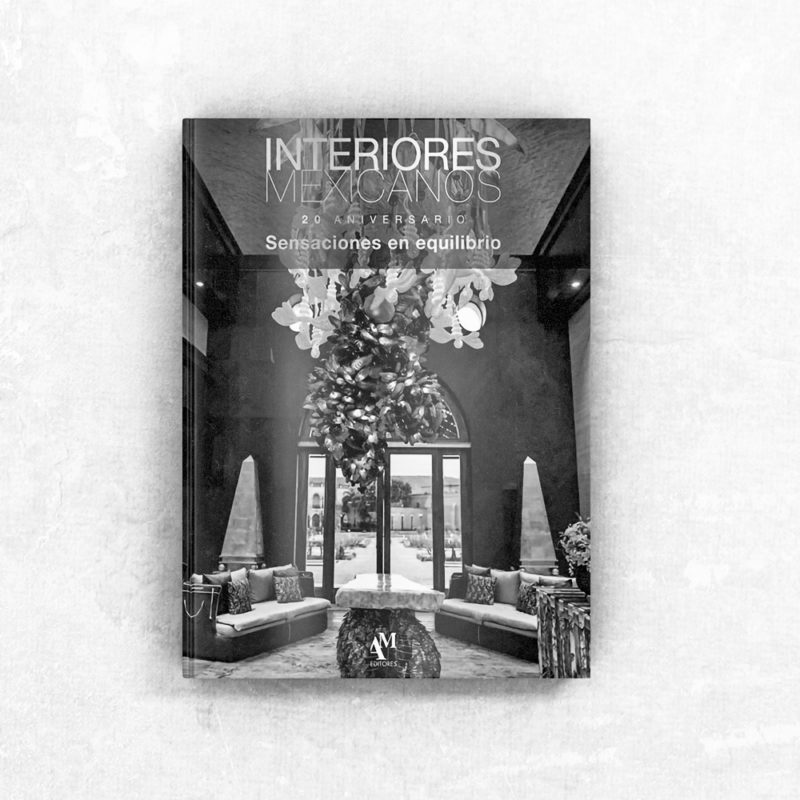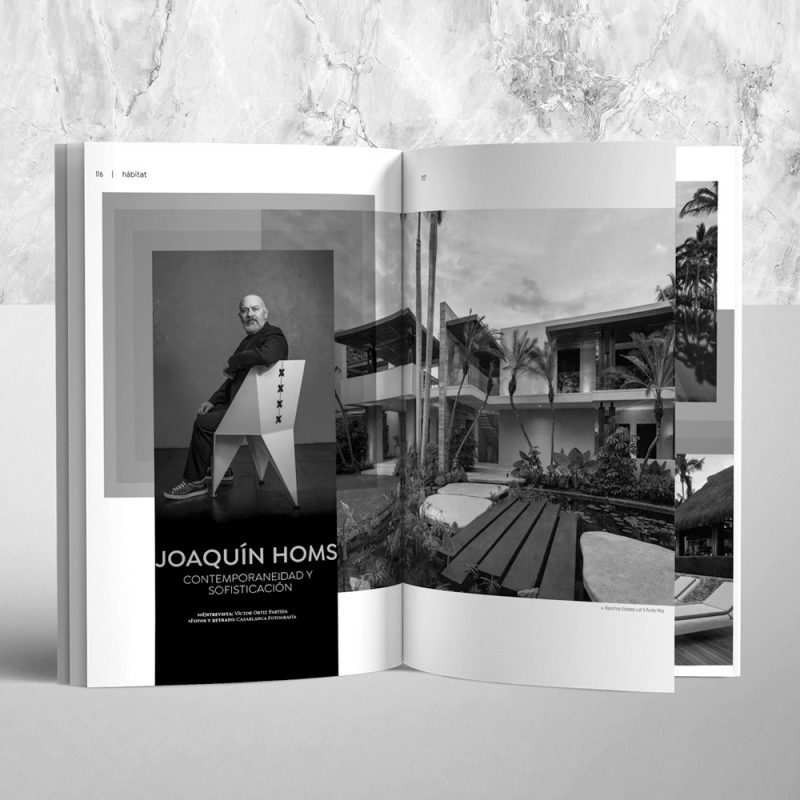Creative, observer and passionate – MOBLAJE
He said that one of the best retributions this profession has is the customer’s satisfaction: observing their reaction when they discover that things were done according to, and even beyond their expectations. Even more when this profession has to do with the creation of spaces where the customer interacts with other people, objects and elements. Being able to confirm there is harmony among all these factors is very rewarding.
Mexico as a design generator
Also a member of Moblaje’s Board of Editors, he thinks Mexico has reached its maturity when it comes to design. “We have been working in this field for many years and many great creators have preceded our architecture in other times, with different requirements, different skills and technologies, all of which has been enriching. We are a country with a great amount of natural wealth, and many things we can observe from the past in order to return to the present, and foresee the future.”
He added that other countries look at Mexico as a country that is a design generator. “At first, I did not notice this fact, as I was immersed in my work. But then I started analyzing the reasons why they called me for certain collaborations (like the time when I collaborated with Point, a company from Spain), and started to have a different point of view. I noticed we have a dormant ability but we are not able to observe it, because we are immersed in the local market.”
When it comes to the future generation of designers, he said the academy must not have limitations, and that it is essential to have a dream, notwithstanding if the project is feasible or not. When the students reach the professional world, they will face the limitations that come along with it, such as budgets or technology. Nonetheless, when they face these issues, and not before that, will be the time for them to find solutions to achieve projects that seemed impossible.
Homs thinks of design and architecture as elements capable of measuring the development of a country, “as they are the reflection of certain moment in societies and cultures, of what is experienced in a specific moment of each nation’s history.” He highlights, for instance: “in Guadalajara, we have witnessed how the housing developments built during the past five years have changed the shape of the city, some of them with good results, others less so. However, they all show the social an economic moment that is taking place.”
Finally, Joaquin Homs stresses that architecture involves each time more and more areas, “because, as architects, our aim isn’t just creating projects from objects, but creating concepts emanating from spaces. Architecture is not an area where we simply create decorative elements. As professionals, we want a comprehensive view of an environment, with a clear objective.
By Rafael Lozornio Barragán
Creative, observer and passionate are three words we could use to define architect Joaquín Homs. As a professional, he has overcome stereotypes by bringing together buildings architecture, interior design, and even furniture design.
In an interview with Moblaje, the distinguished creative emphasized that from an early age he felt attracted to artistic interests, such as playing piano. Admitting being unsuccessful in such practice, he started working on drawing and painting, activities which led him into the world of design, first as a shoemaking creative artist and, subsequently, as an architect.
“There was no family background leading me to arts, design or drawing. I was interested in exploring other cultures, I even thought of becoming a diplomat. However, I coveted something that would allow me to experience, to innovate. In my teenage years, I decided I wanted to be a shoe designer and I even took a course, but by the time I entered high school I was certain that I wanted to study architecture”-he recalls.
Once graduated, he started developing his passion for design. As a professional, he started to learn about other supplementary areas through observation and through the explorer spirit that has always being part of his identity.
And so, he reached the interior design world, an area he also feels passionate about and that has given him great satisfaction. “My interest in painting and drawing has allowed me to develop my ideas and sustain my eagerness to make new things in interior, space and furniture design.”
We must not restrict ourselves
In an exclusive interview with Moblaje, the well-known architect said that his development in different areas since the early nature of his professional activities was paramount to achieve the supplementation with other design disciplines. For this purpose, he worked at Elías + Elías, Alejandro Zohn, and Santoscoy architectural firms.
“Each of these firms has its own style, its own way of working, and its own priorities. I took from each of them the experiences that were useful to my areas of interest and that started defining the direction of my profession”-he said.
As for the inception of his interest for interior design, Joaquin underscores that, in many cases, architects do not consider this area per se but, in his case, he felt attracted to it because of the versatility of the elements he could include in it. “Often,” he said “as architects, we do not see such versatility. However, we need to understand that buildings are also designed from the inside out, and not only the other way around.
He added that “nowadays it is almost compulsory to know other disciplines and to learn how to work with them. Yet, the knowledge that is acquired at the universities is basic and it is each student’s task to build their own criteria to obtain the best part of it. There is a strong influence at the university, because it teaches different ways of gaining knowledge and steering the careers. Once you understand how the different systems work, you obtain freedom to solve the issues and needs of a project from a specific point of view.”
Shutting out the world is a mistake
Homs highlights that architecture, just like other subject areas, needs to be fed and nourished by all the things that are taking place in the architect’s surroundings. What happens in other countries and cultures. It is a profession that has to be open to knowledge and innovation, and has to be in touch with other professionals, even from other fields.
He points out that the world moves by leaps and bounds. “If we just sit there, working only with the things that arise from ourselves and we do not look at what other colleagues are doing in terms of solutions, we could stagnate. What I do,” he explains “is checking on a daily basis what is going on in the world. I spend time observing how design projects are solved in other places. I attend exhibitions as a way of expanding my horizons, instead of just sticking to what I think is correct.”
He agrees with the fact that traveling is necessary. He mentioned, for instance, the famous architect Luis Barragan who, during a time with no internet, and being acknowledged for his creative and professional skills, changed his way of thinking, working, and even designing after a trip.
According to Joaquin, another element an architect needs to consider in order to obtain good results is sensitivity. He adds that good results are not serendipitous: they are based on the previous knowledge and education of the person that is bringing forward a specific project.
Being sensitive is intrinsic and it is implicit from the moment you study the career. You must have cultural baggage preceding knowledge. Before carrying out anything, you must conduct a research. It is not a matter of wisecracks: there is an issue to be solved and you need to be conscious in every aspect. You must know in advance where you want to go.
As for the customer’s degree of maturity to understand the need of hiring professionals to design and develop their spaces, he states it is a field where much remains to be done. However, it might happen insofar as the professionals are able to make their customers understand they care not only for the functional and aesthetical sides of the project, but for guaranteeing the customer’s investment with their job.
Rather than styles, means of providing solutions
We asked him if, within architecture, there were certain styles that professionals stick to. His answer was clear: “I don’t think we should be talking about a specific style, but about a way of solving each one of the projects. Every project has different needs and the point is how to solve such needs.”
He added that there are, indeed, some people who work in a specific way when designing their projects, and that they continue to work in the same way because they have found positive results and it is their best contribution. There might be times when someone wants to set a trend or style, which is all right. It is a decision made by each professional. In the end, the users are the ones to decide over a project and whereas it fulfills their expectations.
Joaquin is a very busy professional, however, he spares time to be close to university students in competitions and conferences, and he states that the academy is a way of enhancing his information background. “Students have plenty of energy and engaging with them provides me with feedback. They are willing to experiment, to try new things. Being in contact with them and sharing some of our experience is fundamental. It is a way to transcend.”
Source: Moblaje Editorial – October 31st, 2016 – DESIGN 404




